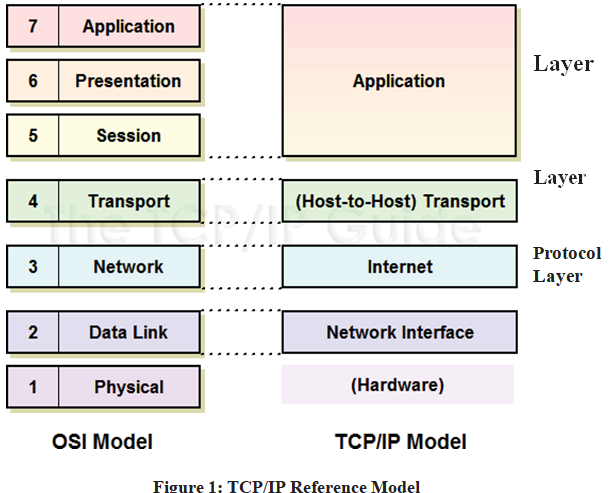Answer:
The TCP/IP protocol architecture is a result of protocol research and development conducted on the experimental packet-switch network. ARPANET, was a research network sponsored by the Defense Advanced Research Projects Agency (DARPA). It eventually connected hundreds of universities and government installations using leased telephone lines. The ability to connect multiple networks together in a perfect way was one of the major design goal. This architecture became known as the TCP/IP reference model. This reference model consists of a large collection of protocols hat have been issued as Internet standards by the Internet Architecture Board (IAB).
TCP/IP Layers:
The TCP/IP model organizes the communication task into five relatively independent layers:
- Physical layer
- Network access layer
- Internet layer
- Host-to-host, or Transport layer
- Application layer
1. The Physical Layer:
The physical layer covers the physical interface between a data transmission device (such as workstation, computer) and a transmission medium or network. This layer is concerned with specifying the characteristics of the transmission medium, the nature of the signals, the data rate and related matters.
2. The Network Access Layer:
The network access layer is concerned with the exchange of data between an end system (server, workstation etc.) and the network to which it is attached. The sending computer must provide the
network with the address of the destination computer, so that the network may route the data to the appropriate destination. The specific software used at this layer depends on the type of the network to be used. Different standards have been developed for frame relay, LAN’s and others. Thus, it makes sense to separate those functions having to do with network access into a separate layer. The network access layer is concerned with access to and routing data across a network for two end systems attached to the same network.

3. The Internet Layer:
If two devices are attached to different networks, procedures are needed to allow data to traverse multiple interconnected networks. This is the function of the internet layer. It holds the whole architecture together. Its job is to permit hosts to injects packets into any network and have them travel independently to the destination (potentially on a different networks). They may even arrive in a different order than they were sent, in which case it is the job of higher layers to rearrange them, if in-order delivery is desired. The similarity here is the (snail) mail system.
This layer defines an official packet format and protocol called IP (Internet Protocol). The job of the internet layer is to deliver IP packets where they are supposed to go. Packet routing is clearly the major issue here, as is avoiding congestion. For these reasons, it is reasonable to say that the TCP/IP internet layer is very similar in functionality to the OSI model’s Network Layer.
4. The Transport Layer (Host-to-Host):
The layer above the internet layer in the TCP/IP model is called the transport layer. It is designed to allow peer entities on the source and destination hosts to carry on a conversation, the same as in the OSI transport layer. Two end-to-end protocols have been defined here. The first one is TCP (Transmission Control Protocol) and second one is UDP (User Datagram Protocol).
The TCP is a reliable connection-oriented protocol that allows a byte stream originating on one machine to be delivered without error on any other machine in the internet. It fragments the incoming byte stream into discrete messages and passes each one onto the internet layer. At the destination, the receiving TCP process reassembles the received messages into the output stream. TCP also handles control to make sure a fast sender cannot swap a slow receiver with more messages than it can handle.
The UDP is an unreliable connectionless protocol for applications that do not want TCP’s sequencing and flow control and wish to provide their own. It widely used for one-shot, client-server type request-reply applications in which prompt delivery is more important than accurate delivery, such a transmitting speech or video. The relation of IP, TCP and UDP is shown in the below diagram.

5. The Application Layer:
Like OSI model, the TCP/IP reference model does not have session or presentation layer. The application layer is located top of the transport layer. It contains all the higher-level protocols. As shown in the above figure, it has FTP (File Transfer Protocol), Telnet, SMTP, and HTTP. The FTP provides a way to move data efficiently from one machine to another. Electronic mail was basically a kind of file transfer, but later a specialized protocol (SMTP) was designed for this purpose. The DNS (Domain Name Server) is used for mapping host name onto their network addresses. And the HTTP (Hyper Text Transfer Protocol) is used for fetching pages on the World Wide Web (WWW) and many other.
Total Views: 85
